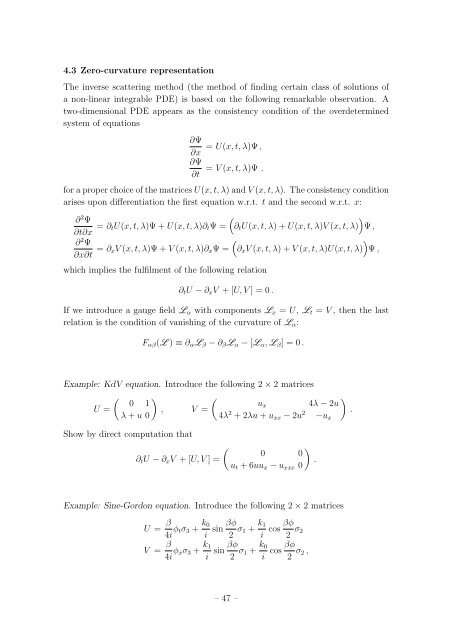Student Seminar: Classical and Quantum Integrable Systems
Student Seminar: Classical and Quantum Integrable Systems
Student Seminar: Classical and Quantum Integrable Systems
You also want an ePaper? Increase the reach of your titles
YUMPU automatically turns print PDFs into web optimized ePapers that Google loves.
4.3 Zero-curvature representation<br />
The inverse scattering method (the method of finding certain class of solutions of<br />
a non-linear integrable PDE) is based on the following remarkable observation. A<br />
two-dimensional PDE appears as the consistency condition of the overdetermined<br />
system of equations<br />
∂Ψ<br />
= U(x, t, λ)Ψ ,<br />
∂x<br />
∂Ψ<br />
= V (x, t, λ)Ψ .<br />
∂t<br />
for a proper choice of the matrices U(x, t, λ) <strong>and</strong> V (x, t, λ). The consistency condition<br />
arises upon differentiation the first equation w.r.t. t <strong>and</strong> the second w.r.t. x:<br />
∂ 2 Ψ<br />
(<br />
)<br />
∂t∂x = ∂ tU(x, t, λ)Ψ + U(x, t, λ)∂ t Ψ = ∂ t U(x, t, λ) + U(x, t, λ)V (x, t, λ) Ψ ,<br />
∂ 2 Ψ<br />
(<br />
)<br />
∂x∂t = ∂ xV (x, t, λ)Ψ + V (x, t, λ)∂ x Ψ = ∂ x V (x, t, λ) + V (x, t, λ)U(x, t, λ) Ψ ,<br />
which implies the fulfilment of the following relation<br />
∂ t U − ∂ x V + [U, V ] = 0 .<br />
If we introduce a gauge field L α with components L x = U, L t = V , then the last<br />
relation is the condition of vanishing of the curvature of L α :<br />
F αβ (L ) ≡ ∂ α L β − ∂ β L α − [L α , L β ] = 0 .<br />
Example: KdV equation. Introduce the following 2 × 2 matrices<br />
( )<br />
(<br />
)<br />
0 1<br />
u<br />
U =<br />
, V =<br />
x 4λ − 2u<br />
λ + u 0<br />
4λ 2 + 2λu + u xx − 2u 2 .<br />
−u x<br />
Show by direct computation that<br />
(<br />
)<br />
0 0<br />
∂ t U − ∂ x V + [U, V ] =<br />
.<br />
u t + 6uu x − u xxx 0<br />
Example: Sine-Gordon equation. Introduce the following 2 × 2 matrices<br />
U = β 4i φ tσ 3 + k 0<br />
i<br />
V = β 4i φ xσ 3 + k 1<br />
i<br />
βφ<br />
sin<br />
2 σ 1 + k 1 βφ<br />
cos<br />
i 2 σ 2<br />
βφ<br />
sin<br />
2 σ 1 + k 0 βφ<br />
cos<br />
i 2 σ 2 ,<br />
– 47 –

















